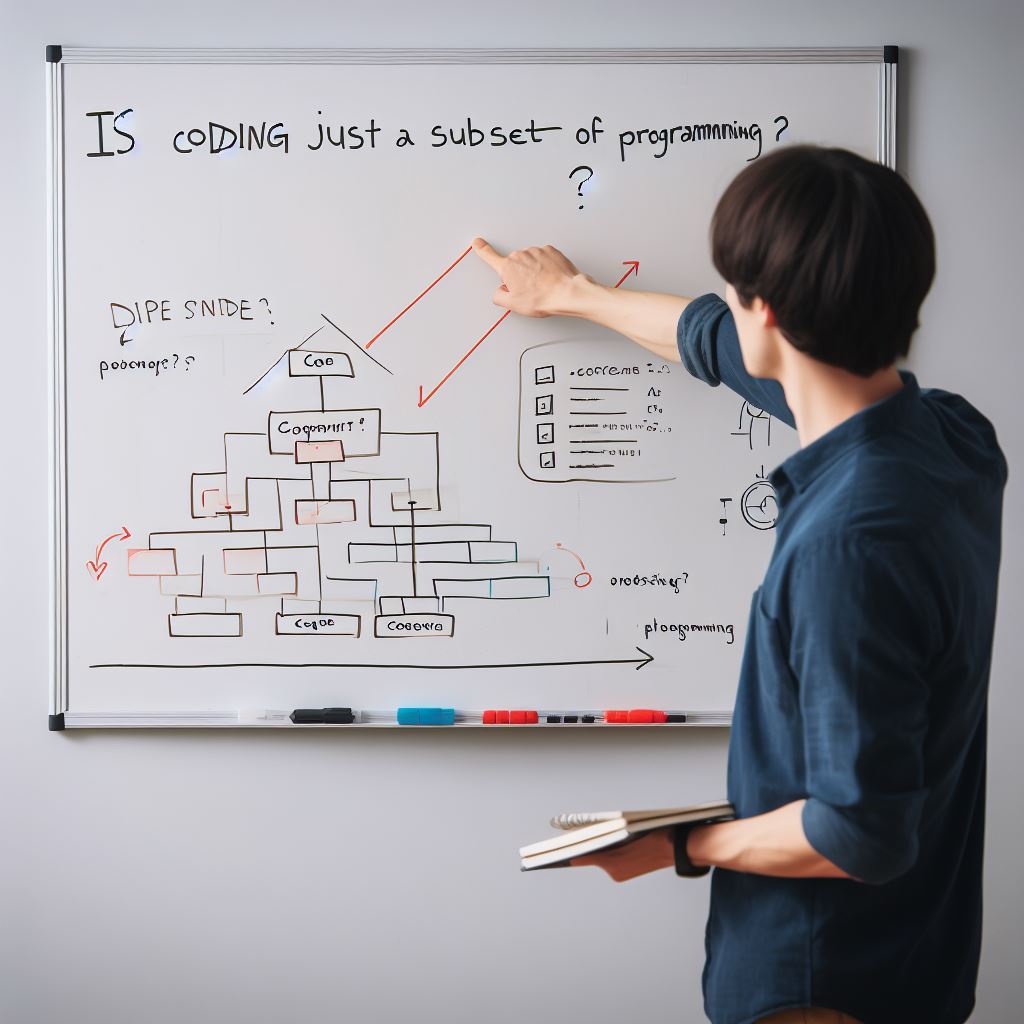Introduction
A. Definition of coding and programming
The relationship between coding and programming is often seen as inseparable, like two sides of the same coin.
Coding refers to the act of writing instructions using a specific programming language.
It involves translating concepts and ideas into a language that a computer can understand and execute.
On the other hand, programming is a more holistic term that encompasses various activities such as problem-solving, algorithm design, testing, and debugging.
B. Coding is indeed a subset of programming
However, it is crucial to note that coding is just one component of programming. Coding alone does not encompass the entire process of programming.
Instead, coding serves as a foundational element within programming. It is the act of writing the lines of codes that form the building blocks of a program.
Considering this relationship, it becomes evident that coding is indeed a subset of programming.
Just as a single dance move contributes to a larger choreography, coding contributes to the overall process of programming.
Without coding, programming cannot exist, but programming extends beyond the act of coding itself.
Coding and programming go hand in hand, with coding being a fundamental aspect of programming.
While coding focuses on writing instructions using a programming language, programming encompasses a broader range of activities.
Understanding this distinction allows us to appreciate the intricate relationship between coding and programming.
Understanding Coding
A. Coding: Crafting Computer Commands
Coding, at its essence, is the art of instructing computers.
It encapsulates the process of writing precise, logical instructions that computers comprehend and execute flawlessly.
B. Diverse Coding Languages: Tools of Precision
- Python: Powers versatile applications, emphasizing simplicity and readability.
- JavaScript: Essential for dynamic web content and interactive user experiences.
- C++: Known for its speed, widely used in game development and system software.
- Java: Favored for building enterprise-level applications across platforms.
C. Real-world Applications: Turning Concepts into Reality
- Algorithms Creation: Algorithms, the backbone of computer science, are meticulously coded for problem-solving.
- Web Development: Coders use languages like HTML, CSS, and JavaScript to craft captivating websites.
- Software Development: Complex software systems are coded using languages like Java or C# for seamless functionality.
In essence, coding is not just a subset of programming; it’s the heartbeat, the very soul of it. Coders, armed with an array of languages, bring innovation to life.
Whether they’re devising intricate algorithms, shaping digital landscapes through web development, or engineering robust software solutions, every keystroke resonates with creativity and logic, making coding the lifeblood of the digital era.
Read: Unix and Linux-Themed Coding Wallpapers You’ll Love
Overview of Programming
A. Definition of programming as a broader process that includes coding
At its core, programming refers to the process of creating computer software.
While coding, which involves writing instructions in a programming language, is an essential part of programming, it is not the only step.
Programming encompasses a broader set of activities that collectively bring about the desired software functionality.
In fact, coding can be seen as just one piece of the puzzle. Programming also involves activities such as planning, designing, and organizing the code structure.
These initial steps are crucial in developing a well-thought-out software solution.
Without proper planning, the software might end up being disorganized, difficult to maintain, or even non-functional.
B. Programming involving various activities besides coding, such as planning, testing, and debugging
Another important aspect of programming is testing. After writing the code, programmers need to check it for errors and bugs.
This involves rigorous testing to ensure that the software functions as expected in different scenarios.
Debugging is also an integral part of programming, as it involves identifying and fixing any issues in the code.
Additionally, programming involves collaborating with others. Programmers often work in teams, which means they need to communicate and coordinate with their peers.
This teamwork is vital in creating complex software systems, where multiple components and modules need to work together seamlessly.
Tech Consulting Tailored to Your Coding Journey
Get expert guidance in coding with a personalized consultation. Receive unique, actionable insights delivered in 1-3 business days.
Get StartedC. The role of programming in creating robust and functional software
Beyond the coding and technical aspects, programming plays a crucial role in creating robust and functional software.
Through programming, developers can implement complex algorithms, data structures, and design patterns.
These elements allow software to handle large amounts of data, solve real-world problems efficiently, and deliver an optimal user experience.
Furthermore, programming enables the creation of reusable code modules, libraries, and frameworks.
By writing code in a modular and reusable manner, programmers can save time and effort in future development projects.
This allows for faster development cycles and promotes code maintainability and scalability.
Programming goes beyond just coding. It involves a range of activities, including planning, testing, and debugging.
By understanding the broader aspects of programming, developers can create robust and functional software that meets the needs of users.
So, the next time you think about programming, remember that it’s not just about writing code – it’s a holistic process that shapes the digital world we live in.
Read: The Rise of Specialized Coding Camps: AI, VR & More

Coding vs. Programming: Different Perspectives
A. Discussion on the opinion that coding and programming are interchangeable terms
Many people believe that coding and programming can be used interchangeably, suggesting they refer to the same thing.
However, a closer examination of the two terms reveals distinct differences.
B. Arguing that coding solely refers to the act of writing instructions, while programming encompasses a broader scope
Contrary to the interchangeable view, coding can be seen as a narrower concept, referring specifically to the process of writing and translating instructions into a language understandable by computers.
On the other hand, programming encompasses a broader scope, involving tasks such as problem analysis, algorithm design, and software development.
While coding is an essential part of programming, it is just one component of a larger process that includes planning, designing, and executing a software solution.
C. Counterarguments stating that coding can indeed be considered a subset of programming depending on the context
Despite the argument made in the previous point, some counterarguments support the idea that coding is a subset of programming, depending on the context in which the terms are used.
In certain situations, coding can become synonymous with programming when it represents the primary activity or skill required for a specific task.
For example, in web development, coding refers to the implementation of designs using HTML, CSS, and JavaScript, which can be considered a subset of the broader programming framework.
In this context, coding is the practical execution of programming concepts, always embedded within the larger process.
Read: Should Your Teen Skip Vacation for Coding Camp?
Build Your Vision, Perfectly Tailored
Get a custom-built website or application that matches your vision and needs. Stand out from the crowd with a solution designed just for you—professional, scalable, and seamless.
Get StartedCoding as a Subset of Programming
A. How coding is a fundamental aspect of programming
Coding is a crucial component of programming, serving as the implementation phase where logical instructions are written.
B. Coding’s role in translating algorithms into a machine-readable format
Furthermore, coding plays a significant role in converting algorithms into a format that computers can understand and execute.
C. Illustrating that coding is an integral part of the programming process
For instance, when creating a website, coding is necessary for designing the layout, functionality, and interactivity of the webpages.
Similarly, in software development, coding is involved in writing the instructions that enable the program to perform specific tasks.
Coding is also vital in fields like data science, where algorithms are written in languages like Python or R to analyze and manipulate data.
Moreover, in game development, coding is essential for creating the game mechanics, user interface, and overall gameplay experience.
Coding is a fundamental and indispensable component of the programming process.
It involves translating logical instructions into a machine-readable format, enabling the creation of diverse software applications and systems.
By understanding that coding is just a subset of programming, one can appreciate its significance in bringing innovative ideas to life.
Read: Veterans and Coding Camps: A Perfect Match?
Conclusion
A. Coding Within the Realm of Programming
In reaffirming our thesis, coding is undoubtedly a pivotal subset of the intricate world of programming.
B. Key Takeaways
- Interconnectedness: Coding and programming are interwoven, each reliant on the other’s expertise.
- Precision and Creativity: Coding demands precision, while programming thrives on creative problem-solving.
- Collaborative Synergy: Programmers and coders collaborate synergistically, crafting innovative digital solutions.
C. Final Reflections
Understanding coding’s role in programming is akin to grasping the alphabet in the language of technology.
It empowers individuals, fostering a new generation of problem solvers and innovators.
Embracing this symbiotic relationship illuminates the path toward mastering the broader realm of programming, where limitless possibilities await those fluent in the language of both code and concept.




